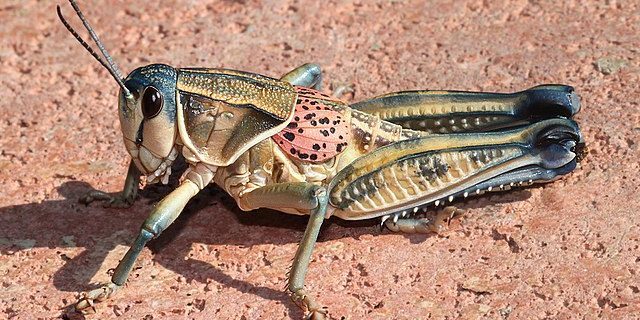21
Jul
Millions of Acres in West To Be Sprayed with Toxic Insecticides for Grasshoppers

(Beyond Pesticides, July 21, 2021) Western states are in the midst of one of the largest spray campaigns in recent history, targeting native grasshopper species on more than two million acres of rangeland with highly toxic insecticides. Grasshopper populations have exploded this year due to the West’s ongoing drought, and government officials at the U.S. Department of Agriculture are hoping that hazardous pesticide use will stop the voracious winged insects from consuming forage used by cattle operations. Environmental groups are urging changes to the program, which has conducted insecticide campaigns against the native grasshoppers since the 1930s. “Aerial application of insecticides on this scale will eliminate millions of insects that pollinate, recycle plant nutrients and perform natural pest control,” said Sharon Selvaggio, Pesticide Program Specialist with the Xerces Society. “Insecticide sprays on this scale across native ecosystems are short-sighted and unsustainable.”
According to a June 2020 press release, USDA’s Animal and Plant Health Inspection Service (APHIS) is spending $5.3 million dollars of taxpayer money in order to conduct what it calls “suppression treatments.” APHIS claims the $5.3 million will protect $8.7 million worth of agricultural resources, but advocates argue that the agency has failed to meet the “level of economic threshold” required under federal law to justify spraying. Calculations indicate that spraying costs between roughly $2-45 per acre, while the American taxpayer generates roughly $0.17 per acre from grazing leases that charge ranchers a mere $1.35/month to place cattle on public lands in the west.
Moreover, APHIS’s justification of the expense does not include an evaluation of the ecological costs of the spray campaign. The agency assumes the spray campaign will adequately address the grasshopper infestation, but fails to account for the value of natural predators. Indiscriminate pesticide spray applied across large swaths of land are sure to kill off natural enemies of grasshopper species that may otherwise control the animals and could help prevent future infestations.
In addition to natural predators, there is significant value that can be ascribed to pollinators and other beneficial species that are likely to have their populations reduced by pesticide applications. Western monarch butterflies are on the precipice of extinction, and need improved conditions, not increased threats in order to stave off the worst.
Organic farmers in states like Montana are split on the campaign, according to reports in the Associated Press. Concerns over the loss of certification are butting up against the desire to be a good neighbor. As with other issues concerning drift and organic farming, the onus is on the organic farmer to protect their crops from chemical exposure, not on the applicator to prevent pesticide trespass. This creates an uneven playing field that tilts towards pesticide use as the status quo, despite organic practices being the least impactful, and most sustainable approach to farming and pest management.
Over the last 15 years, APHIS has primarily relied on the hazardous insecticide diflubenzuron to manage the grasshoppers. But there is indication that, if conditions persist, the agency could employ malathion and carbaryl— some of the most toxic pesticides that remain on the market. Malathion is an acutely toxic organophosphate insecticide that is associated with neurotoxicity, kidney and liver damage, and cancer. A recently published investigative report in The Intercept found that the U.S. Environmental Protection Agency has dismissed evidence linking malathion to cancer for decades. Malathion is also highly toxic to birds and pollinators, and its use jeopardizes over 1,000 endangered species throughout the country.
Carbaryl is a carbamate insecticide that has also been linked to a range of health impacts, from cancer to diabetes and other metabolic diseases, as well as birth defects at concerning low levels. It is acutely toxic to birds, pollinators, and aquatic organisms.
Attempts by APHIS to “suppress” natural fluxes in grasshopper populations are reminiscent of misguided and continued attempts to suppress other natural disturbances in the west, like fires. But, as time has shown, suppression only delays the inevitable. The result is hotter fires, and more intense swings within grasshopper populations. After nearly 100 years of Sisyphean action, advocates are urging APHIS to make this year the last time the federal government conducts this massive ecological poison campaign.
Instead of placing blame on natural processes in order to protect grazing practices that are not natural and in many ways damaging to local ecology, focus should be placed on the human element. Rather than spend millions of dollars on pesticide use, the federal government should make sure that farmers and ranchers who are affected by grasshoppers be adequately compensated for their loss. The widespread use of highly toxic insecticides that can devastate the local environment need not factor in. Supporting and increasing natural biodiversity, utilizing local fire regimes, and incentivizing modified grazing practices like rotational grazing can all help lessen the effects of grasshoppers on US public lands.
For more information about the dangers pesticides pose to wildlife and biodiversity, see Beyond Pesticides program pages.
All unattributed positions and opinions in this piece are those of Beyond Pesticides.
Correction: This post was updated to specify the date of the USDA APHIS press release, and clarify the primary insecticide APHIS has been using to manage grasshoppers.
Source: Associated Press, Xerces Society










